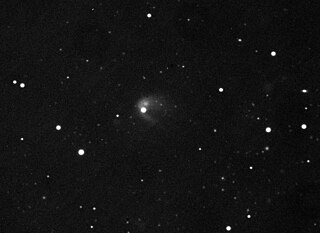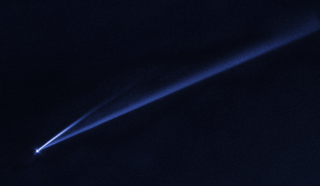
A comet is an icy, small Solar System body that warms and begins to release gases when passing close to the Sun, a process called outgassing. This produces an extended, gravitationally unbound atmosphere or coma surrounding the nucleus, and sometimes a tail of gas and dust gas blown out from the coma. These phenomena are due to the effects of solar radiation and the outstreaming solar wind plasma acting upon the nucleus of the comet. Comet nuclei range from a few hundred meters to tens of kilometers across and are composed of loose collections of ice, dust, and small rocky particles. The coma may be up to 15 times Earth's diameter, while the tail may stretch beyond one astronomical unit. If sufficiently close and bright, a comet may be seen from Earth without the aid of a telescope and can subtend an arc of up to 30° across the sky. Comets have been observed and recorded since ancient times by many cultures and religions.

Scheila is a main-belt asteroid and main-belt comet orbiting the Sun. It was discovered on 21 February 1906 by August Kopff from Heidelberg. Kopff named the asteroid after a female English student with whom he was acquainted.

The Panoramic Survey Telescope and Rapid Response System located at Haleakala Observatory, Hawaii, US, consists of astronomical cameras, telescopes and a computing facility that is surveying the sky for moving or variable objects on a continual basis, and also producing accurate astrometry and photometry of already-detected objects. In January 2019 the second Pan-STARRS data release was announced. At 1.6 petabytes, it is the largest volume of astronomical data ever released.

Active asteroids are small Solar System bodies that have asteroid-like orbits but show comet-like visual characteristics. That is, they show a coma, tail, or other visual evidence of mass-loss, but their orbits remain within Jupiter's orbit. These bodies were originally designated main-belt comets (MBCs) in 2006 by astronomers David Jewitt and Henry Hsieh, but this name implies they are necessarily icy in composition like a comet and that they only exist within the main-belt, whereas the growing population of active asteroids shows that this is not always the case.

6478 Gault, provisional designation 1988 JC1, is a Phocaea asteroid from the inner regions of the asteroid belt, approximately 3.7 kilometers (2.3 miles) in diameter. The likely S-type asteroid was discovered on 12 May 1988, by astronomer couple Carolyn and Eugene Shoemaker at the Palomar Observatory in California. It was named in honor of planetary geologist Donald Gault. In January 2019, it was found that Gault shows cometary activity and that it has multiple tails, making it an active asteroid. It was subsequently realised that it had been active since at least 2013.

354P/LINEAR, provisionally designated P/2010 A2 (LINEAR), is a small main-belt asteroid that was impacted by another asteroid sometime before 2010. It was discovered by the Lincoln Near-Earth Asteroid Research (LINEAR) at Socorro, New Mexico on 6 January 2010. The asteroid possesses a dusty, X-shaped, comet-like debris trail that has remained nearly a decade since impact. This was the first time a small-body collision had been observed; since then, minor planet 596 Scheila has also been seen to undergo a collision, in late 2010. The tail is created by millimeter-sized particles being pushed back by solar radiation pressure.

C/2011 L4 (PanSTARRS), also known as Comet PANSTARRS, is a non-periodic comet discovered in June 2011 that became visible to the naked eye when it was near perihelion in March 2013. It was discovered using the Pan-STARRS telescope located near the summit of Haleakalā, on the island of Maui in Hawaii. Comet C/2011 L4 probably took millions of years to come from the Oort cloud. After leaving the planetary region of the Solar System, the post-perihelion orbital period is estimated to be roughly 107000 years. Dust and gas production suggests the comet nucleus is roughly 1 kilometer (0.62 mi) in diameter, while based on the absolute nuclear magnitude and a geometric albedo of 0.04 the diameter of the nucleus is over 2.4 kilometers (1.5 mi). A method based on coma magnitude decay function estimated the effective radius at 2.317 ± 0.190 km.

C/2014 Q1 (PanSTARRS) is a non-periodic/long period comet discovered on 16 August 2014 by the Panoramic Survey Telescope and Rapid Response System (Pan-STARRS). The comet after its perihelion on July 6, 2015 reached a magnitude of +4 while being in evening twilight. The comet after perihelion featured three tails.

Comet 252P/LINEAR is a periodic comet and near-Earth object discovered by the LINEAR survey on April 7, 2000. The comet is a Jupiter family comet, meaning that it passes quite close to the orbit of Jupiter.

460P/PanSTARRS (also known with the provisional designation P/2016 BA14) is a near-Earth object and periodic comet of the Jupiter family, with an orbital period of 5.25 years. In March 2016 it passed at distance of 2.2 million miles (3.5 million km, or 9 lunar distances) from Earth. It was the closest approach by a comet since 1770 and 3rd closest recorded comet to Earth. The close flyby enabled the size of the nucleus to be calculated at about 1 km (0.62 mi) in diameter, which was much bigger than expected. The comet is very dark, reflecting about 2-3 percent of the visible light, about the same as a charcoal briquette. It has a very similar orbit as numbered comet 252P/LINEAR, and may be related to it (e.g. split off of).

(300163) 2006 VW139 (provisional designation 2006 VW139, periodic comet designation 288P/2006 VW139) is a binary active asteroid and main-belt comet from the outer regions of the asteroid belt. The object was discovered by Spacewatch in 2006. Its binary nature was confirmed by the Hubble Space Telescope in September 2016. Both primary and its minor-planet moon are similar in mass and size, making it a true binary system. The components are estimated to measure 1.8 kilometers in diameter, orbiting each other at a wide separation of 104 kilometers every 135 days.

C/2017 K2 (PanSTARRS) is an Oort cloud comet with an inbound hyperbolic orbit, discovered in May 2017 at a distance beyond the orbit of Saturn when it was 16 AU (2.4 billion km) from the Sun. Precovery images from 2013 were located by July. It had been in the constellation of Draco from July 2007 until August 2020. As of June 2022, the 3-sigma uncertainty in the current distance of the comet from the Sun is ±6000 km.

C/2016 R2 (PanSTARRS) is a comet, discovered using the Pan-STARRS telescopes on September 7, 2016. The comet attracted attention from many astronomers as it approached its closest point to the sun in May 2018. It has been observed to have a very complex tail, which has been suggested to be due to a fast rotation period of the nucleus.
A Manx comet is a class of rocky, minor, celestial bodies that have a long-period comet orbit. Unlike most bodies on a long-period comet orbit which typically sport long, bright tails, a Manx comet is tailless, more typical of an inner Solar System asteroid. The nickname comes from the Manx breed of tailless cat. Examples include C/2013 P2 (PANSTARRS), discovered on 4 August 2013, which has an orbital period greater than 51 million years, and C/2014 S3 (PANSTARRS), discovered on 22 September 2014, which is thought to originate from the Oort cloud and could help explain the formation of the Solar System.

2I/Borisov, originally designated C/2019 Q4 (Borisov), is the first observed rogue comet and the second observed interstellar interloper after ʻOumuamua. It was discovered by the Crimean amateur astronomer and telescope maker Gennadiy Borisov on 29 August 2019 UTC.
P/2016 G1 (PanSTARRS) was a main-belt asteroid that was destroyed by an impact event on 6 March 2016. It was discovered by Robert Weryk and Richard Wainscoat of the Pan-STARRS 1 survey at Haleakala Observatory. The object was initially thought to be an Encke-type comet because of its diffuse appearance, so it received the periodic comet designation P/2016 G1. After further analysis, what had initially appeared to be a comet's halo turned out to be rubble from a collision. By November 2019, analysis suggested the collision had occurred on 6 March 2016, and the asteroid was struck by a smaller object that may have massed only 1 kilogram (2.2 lb), and was traveling at 11,000 miles per hour (18,000 km/h). P/2016 G1's diameter was between 200 metres (660 ft) and 400 metres (1,300 ft). The asteroid had completely disintegrated by 2017.
C/2021 O3 (PanSTARRS) is perhaps an Oort cloud comet, discovered on 26 July 2021 by the Pan-STARRS sky survey. It came to perihelion on 21 April 2022 at 0.287 AU (42.9 million km). from the Sun.

P/2013 R3 (Catalina–PanSTARRS) was an active main-belt asteroid that disintegrated from 2013 to 2014 due to the centrifugal breakup of its rapidly-rotating nucleus. It was discovered by astronomers of the Catalina and Pan-STARRS sky surveys on 15 September 2013. The disintegration of this asteroid ejected numerous fragments and dusty debris into space, which temporarily gave it a diffuse, comet-like appearance with a dust tail blown back by solar radiation pressure. Observations by ground-based telescopes in October 2013 revealed that P/2013 R3 had broken up into four major components, with later Hubble Space Telescope observations showing that these components have further broken up into at least thirteen smaller fragments ranging 100–400 meters (330–1,310 ft) in diameter. P/2013 R3 was never seen again after February 2014.

P/2016 J1 (PanSTARRS) is a pair of active main-belt asteroids that split apart from each other in early 2010. The brightest and largest component of the pair, P/2016 J1-A, was discovered first by the Pan-STARRS 1 survey at Haleakalā Observatory on 5 May 2016. Follow-up observations by the Canada-France-Hawaii Telescope at Mauna Kea Observatory discovered the second component, P/2016 J1-B, on 6 May 2016. Both asteroids are smaller than 1 kilometre (0.62 mi) in diameter, with P/2016 J1-A being roughly 0.6 km (0.37 mi) in diameter and P/2016 J1-B being roughly 0.3 km (0.19 mi) in diameter. The two components recurrently exhibit cometary activity as they approach the Sun near perihelion, suggesting that their activity is driven by sublimation of volatile compounds such as water.




















